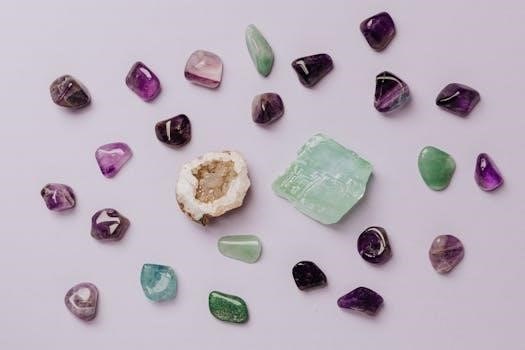Gold-Bearing Rock Identification⁚ A Comprehensive Guide
Embark on your prospecting journey with our comprehensive guide! Download a FREE rock identification PDF to spot gold-bearing rocks. This helps unlock Earth’s secrets and discover hidden treasures, aiding identification. Remember to research gold-mining areas.
Gold exploration and evaluation requires understanding the general framework of primary and secondary gold resources. Our guide introduces you to identifying rocks likely to contain gold. This involves learning about their geological origins, mineral properties, and common indicators. By researching known gold-bearing areas with a history of mining, you increase your chances of success. Download our rock identification PDF guide to become a gold prospector! Discover how to recognize gold at home, starting your journey towards finding hidden treasures, safely and legally, always considering past mining activity.
Understanding Gold Hallmarks and Markings
This section guides you in reading gold identification marks on jewelry. Quickly identify the karat quality of each piece and its maker. Decipher markings to determine authenticity and gold content efficiently.
Identifying Gold Karat Quality
Understanding gold karat quality is crucial for determining the purity and value of your gold items. Karat markings indicate the percentage of pure gold present in the alloy. For instance, 18K gold signifies 75% pure gold, often stamped as “750” in Europe or “18K,” “18KT,” or “.750” in the U.S. Identifying these markings allows you to quickly assess the gold content. Being able to read these markings will help you determine if the gold you are looking at is worth prospecting.
Recognizing Maker’s Marks and Their Significance
Maker’s marks are unique stamps placed on jewelry and watches, ensuring the manufacturer’s authenticity. They often consist of the manufacturer’s initials, name, or a unique symbol. Identifying these marks is the first step in determining a piece’s value and provenance. These marks help trace the origin and craftsmanship of the item. Recognizing these symbols is a key aspect of assessing the jewelry. Always inspect for these marks.
Visual Identification of Gold in Rocks
Identifying gold in rocks requires keen observation. This article delves into various methods, comparing effectiveness and ease of use. This helps make informed decisions during prospecting. Download a rock identification PDF guide to improve your skills.
Recognizing Common Gold Indicators in Rocks
Identifying gold indicators involves careful observation. Look for specific rock types and mineral associations. Pyrite, often called “fool’s gold,” can sometimes be found near real gold. Quartz veins are another common indicator. Research known gold-bearing areas for better success. Download a rock identification PDF guide to aid in your search. Examine rocks for unusual staining or alteration. Remember that visual identification is just the first step; professional assaying provides certainty. Use a guide to learn what to look for.

At-Home Gold Testing Methods
Distinguish real gold from imitations using at-home tests. These methods offer a starting point, but professional assaying ensures certainty. Learn quick tests, but remember limitations.
The Scratch Test
The scratch test is a preliminary method to assess the authenticity of gold. Gently scratch the item on a testing stone. Gold leaves a distinct mark. Compare the scratch with known gold samples. A faint or non-existent scratch suggests it might not be pure gold. However, this test is not foolproof. It should be complemented with other tests for a more accurate determination. Remember that absolute certainty requires professional assaying, but these at-home tests provide a good starting point.
Density Test for Gold Identification
The density test is a more reliable method for gold identification. Gold has a high density. To perform this test, weigh the sample, then measure its volume by water displacement. Divide the mass by the volume to calculate the density. Pure gold has a density of approximately 19.3 g/cm³. If the calculated density is significantly lower, the item is likely not pure gold. Remember, absolute certainty requires professional assaying, but these at-home tests provide a good starting point.

Professional Gold Assaying
For definitive gold identification, seek professional assaying. Experts use advanced techniques to accurately determine gold content. This is crucial for valuable finds or when at-home tests are inconclusive, ensuring precise evaluation.
When to Seek Professional Gold Testing
While at-home methods offer a starting point, absolute certainty demands professional gold testing. If you suspect a significant gold concentration or encounter inconclusive results from DIY tests, expert assaying is crucial. This ensures accurate gold content determination, particularly vital for valuable finds or potential investment.
Professional assaying employs sophisticated techniques, eliminating ambiguities and providing precise quantification. It’s also recommended when dealing with complex ore samples or when legal verification of gold content is required, offering the most reliable assessment.
Prospecting for Gold⁚ Safety and Legality
Prospecting requires research in known gold-bearing areas with a history of gold mining. Prioritize safety and legality. Beginners should consult guides for safe practices and understand legal regulations before prospecting.
Researching Known Gold-Bearing Areas
Before venturing out, thorough research is crucial. Focus on areas with a history of successful gold mining, avoiding arbitrary locations. Prospecting in regions showing signs of past mining activity increases your chances of success. Consult geological surveys, historical records, and local mining claims. Understanding the geological context of these areas is essential. Identify the types of rocks and mineral deposits known to host gold. This will inform your rock identification efforts and improve your prospecting outcomes. Always respect private property and adhere to all environmental regulations.
Gold Filled vs. Solid Gold
Understanding the difference is crucial! Gold filled (GF) comprises a gold layer (10ct+) fused to a base metal. Rolled Gold (RG) is a synonym. Solid gold has consistent gold content throughout the piece.
Understanding Gold Filled Markings (GF, RG)
Gold filled (GF) markings indicate a layer of gold (at least 10ct) mechanically bonded to a base metal. This process involves heat and pressure, creating a durable surface. Rolled Gold (RG) is an equivalent term, signifying the same manufacturing technique. Unlike solid gold, the gold layer in GF items isn’t consistent throughout the entire piece. These markings offer insight into a jewelry item’s construction, where a thin gold layer is applied. Thus, understanding GF and RG markings helps accurately assess value and composition.

Tools for Gold Prospecting and Rock Identification
Equip yourself for success! Download our FREE rock identification PDF guide to learn how to spot gold-bearing rocks. This resource helps discover hidden treasures and unlock the earth’s secrets, helping you identify valuable specimens!
Rock Identification PDF Guides and Resources
Unlock the secrets of gold prospecting with readily available PDF guides! These resources provide valuable information on identifying various rock types and recognizing common gold indicators. Download a FREE rock identification PDF guide to spot gold-bearing rocks. These comprehensive guides often include visual aids, mineral descriptions, and formation processes.
They equip both beginners and experienced prospectors with the knowledge needed to differentiate between promising samples and worthless rocks, ultimately increasing success in the field, leading to discovery of hidden treasures and unlocking the secrets of the Earth.
Hallmarks on Antique Gold
Delve into the world of antique gold! Our beginner’s guide unravels antique gold hallmarks answering when gold stamping began. Explore anchor marks and more, aiding in understanding the history and value of your antique pieces.
Understanding Antique Gold Hallmarks
Antique gold hallmarks offer a window into the past, revealing details about a piece’s origin and composition. These markings, often small and intricate, provide valuable clues about the gold’s purity, the maker, and the year it was created. Identifying these marks requires careful observation and knowledge of historical hallmarks. This knowledge helps in understanding a piece’s worth and authenticity. Consulting a comprehensive guide or expert can further clarify the meaning behind these fascinating symbols, linking you to the rich history of gold jewelry. Proper identification reveals a piece’s true value.

Gravity Methods for Gold Ore Processing
Gravity methods are a widely used approach for processing gold ores, separating gold from other materials based on density differences. These techniques are essential in gold extraction processes, offering a cost-effective and relatively simple way to concentrate gold particles. However, many aspects of these processing techniques require improvement. Research into enhancing gravity methods is ongoing, focusing on optimizing efficiency and minimizing environmental impact. Understanding the principles and applications of gravity methods is crucial for anyone involved in gold ore processing, ensuring effective and sustainable gold recovery from various ore types which is a common practice.
Comments